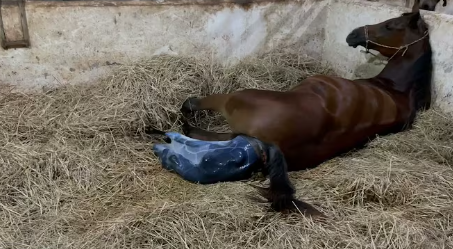A Raw and Beautiful Look at New Life in the Stable
Bringing a new life into the world is always a powerful moment—one that stirs emotion, awe, and deep respect for nature. When it comes to horses, this experience is especially moving. The strength, grace, and instinct of a mare giving birth to her foal is something few people ever witness firsthand.
In this horse giving birth compilation 🐴, we bring together real, unfiltered footage of mares foaling—sharing the raw, tender, and sometimes intense moments that lead to the birth of a baby horse. From early labor signs to first steps, every clip tells a story of life, nature, and the incredible bond between mare and foal.
Understanding the Horse Birthing Process (Foaling)
A horse’s pregnancy, also called gestation, lasts around 11 months. As the due date approaches, experienced horse owners and breeders begin watching the mare closely for physical and behavioral signs of impending labor. These signs include swelling of the udder (bagging up), relaxation of the muscles around the tail, changes in behavior, and restlessness.

Once labor begins, the process happens fairly quickly—much faster than in cows or humans. Mares generally prefer a quiet, dark environment and often give birth at night or in early morning hours when it’s calm.
The birthing process is divided into three main stages:
Stage 1: Early Labor
This stage can last several hours. The mare may seem anxious, pace her stall, lie down and stand up repeatedly, or begin sweating. This is the body preparing for delivery, and contractions are beginning internally. At this point, the mare should be closely monitored, but not disturbed.
Stage 2: Active Labor and Foal Delivery
Once the mare lies down and begins actively pushing, this signals the start of Stage 2. This is the most dramatic and critical part of the birthing process. A normal presentation starts with two front hooves and the foal’s nose visible inside the amniotic sac. With each push, more of the foal is delivered until it slips completely out, often still covered in the sac.
This stage usually lasts between 10 to 30 minutes. If it goes longer, or the foal is not presenting correctly, assistance may be needed. But in most cases, mares give birth naturally with little to no help.
Stage 3: Expulsion of the Placenta
After the foal is born, the mare will rest briefly while the placenta is delivered. This stage usually occurs within 1 to 3 hours after birth. It’s important that the entire placenta is passed to prevent infection or complications.
Emotional Moments Captured in This Compilation
Each birth shown in this compilation is unique. Some mares deliver in quiet, private stalls. Others give birth in the open pasture surrounded by fresh air and sunlight. Regardless of setting, the emotions are the same—intensity, relief, love, and awe.
You’ll see moments of clear instinct as the mare turns to lick her foal, stimulating circulation and breathing. The foal, though wobbly, will often try to stand within 30 minutes, guided by nature and encouraged by its mother’s nudging.
In several clips, you’ll witness:
- The precise moment a foal’s hooves first appear
- The mare’s powerful pushing as labor intensifies
- The calm after delivery, as mother and baby bond
- The foal’s shaky but determined first steps
- Nursing for the first time—a critical moment of nutrition and bonding
These scenes are not only beautiful—they’re educational. They reveal what normal foaling looks like and help viewers, especially new breeders or horse owners, understand when things are going smoothly and when intervention may be needed.
Why This Footage Matters
Horse births are rarely seen by the public. Mares often foal at night or in privacy, making it difficult to capture these moments unless someone is carefully watching and ready to film. That’s what makes this compilation so special. It offers a rare look into a sacred process that few outside the equestrian world ever witness.
For horse lovers, these videos stir emotion and admiration. For breeders and caretakers, they offer useful insight. And for those simply curious about life on the farm or in the stable, these birth stories provide a close-up view of how nature brings life into the world through strength, instinct, and love.
The Beauty and Strength of the Mare
One of the most striking things about horse births is how instinct-driven and graceful they are. Despite the physical challenge, most mares handle birth with quiet resilience. They lie down, push, rest, and then immediately begin caring for their newborn.
The bond between mare and foal is instantaneous. The mother guides her baby, protects it, and ensures it finds milk. Watching that connection form in real-time is deeply moving and inspiring.
Final Thoughts
The Horse Giving Birth Compilation 🐴 is a heartfelt celebration of life, resilience, and motherhood in the animal kingdom. From the first signs of labor to the foal’s first wobbly steps, these moments are a testament to the incredible strength and beauty of horses.
Whether you’re a breeder, trainer, animal enthusiast, or simply someone who appreciates the magic of new life, this compilation is sure to leave a lasting impression. It’s a reminder that life, in all its forms, is a gift—and sometimes, the most meaningful moments happen in the quiet corners of a stable.